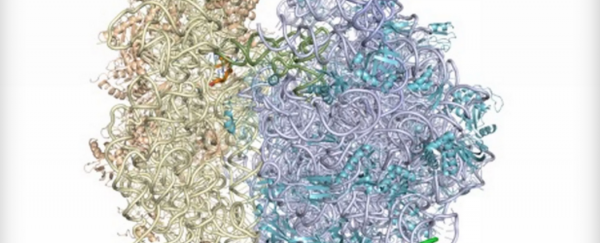Researchers in the US have developed a synthetic molecular structure called the Ribo-T, and it can be placed inside a living cell to produce specialised proteins and enzymes at almost the same efficiency as an actual ribosome.
Found inside all living cells, ribosomes are dense, complex structures that catalyse a constant stream of protein chains by linking amino acids together in the order specified by messenger RNA (mRNA) molecules. These cellular workhorses are basically in charge of decoding your DNA, and now scientists have manufactured a molecular device that can not only produce protein chains in a test-tube almost as well as a real ribosome, but can also churn out enough protein in bacterial cells without any natural ribosomes to keep them alive.
The team, with researchers from the University of Illinois at Chicago and Northwestern University, says not only will the Ribo-T help them to better understand how our own ribosomes function, but it could lead to more effective drugs and next-gen biomaterials, with these little protein factors churning out whatever we need.
"We felt like there was a small - very small - chance Ribo-T could work, but we did not really know," one of the team, Alexander Mankin from the University of Illinois at Chicago, said in a press release. The key to Ribo-T's success was how they ended up tweaking the natural structure of their ribosome.
As Arielle Duhaime-Ross explains at The Verge, natural ribosomes float around inside a cell in two halves (or subunits), and only link up when they need to link some protein chains together. "To keep the lab-made ribosome from linking up with the naturally occurring ones - which would kill the cell - the scientists tethered the two halves together," says Duhaime-Ross.
Because Ribo-T is tethered shut and can never separate like a natural ribosome, all kinds of new and amazing things can be cooked up inside, such as unique polymers that can help us track processes inside the ribosome, the researchers say.
"What we were ultimately able to do was show that by creating an engineered ribosome where the ribosomal RNA is shared between the two subunits and linked by these small tethers, we could actually create a dual translation system," said one of the researchers, Michael Jewett, a synthetic biologist from Northwestern University.
While the engineered ribosomes exceeded all expectations in terms of how effective they are, they are far from perfect. Reporting in Nature, the team says that while bacterial cells with no natural ribosomes at all could live off the proteins produced by an army of Ribo-Ts, they grew at half the speed of normal cells.
"Our tethered ribosome is good, but not as good as 'normal' ribosome," Mankin told The Verge. But never say never, because the team is hopeful that with a few years under its belt, Ribo-T be a whole lot more efficient than it is now. It'll never catch up to the several billion years of evolution that our ribosomes have had to perfect their craft, but let's not rush things just yet, says Mankin, "our Ribo-T is only one year old!"
